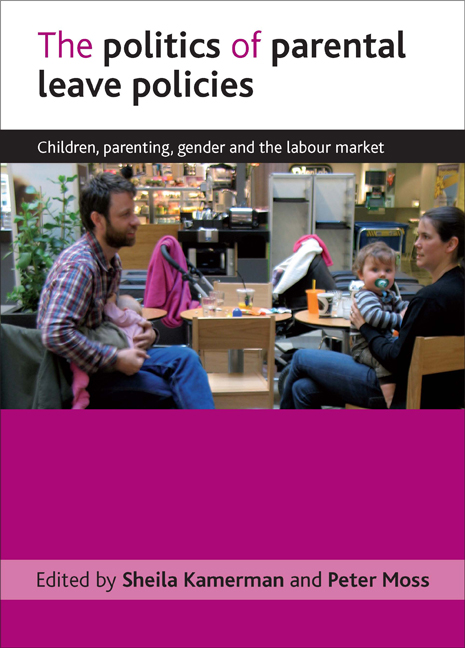Book contents
- Frontmatter
- Contents
- List of tables and figures
- Acknowledgements
- Notes on contributors
- one Introduction
- two Australia: the difficult birth of paid maternity leave
- three Canada and Québec: two policies, one country
- four Czech Republic: normative or choice-oriented system?
- five Estonia: halfway from the Soviet Union to the Nordic countries
- six Finland: negotiating tripartite compromises
- seven France: gender equality a pipe dream?
- eight Germany: taking a Nordic turn?
- nine Hungary and Slovenia: long leave or short?
- ten Iceland: from reluctance to fast-track engineering
- eleven The Netherlands: bridging labour and care
- twelve Norway: the making of the father’s quota
- thirteen Portugal and Spain: two pathways in Southern Europe
- fourteen Sweden: individualisation or free choice in parental leave?
- fifteen The European directive: making supra-national parental leave policy
- sixteen Conclusion
- Appendix
- Index
fifteen - The European directive: making supra-national parental leave policy
Published online by Cambridge University Press: 05 July 2022
- Frontmatter
- Contents
- List of tables and figures
- Acknowledgements
- Notes on contributors
- one Introduction
- two Australia: the difficult birth of paid maternity leave
- three Canada and Québec: two policies, one country
- four Czech Republic: normative or choice-oriented system?
- five Estonia: halfway from the Soviet Union to the Nordic countries
- six Finland: negotiating tripartite compromises
- seven France: gender equality a pipe dream?
- eight Germany: taking a Nordic turn?
- nine Hungary and Slovenia: long leave or short?
- ten Iceland: from reluctance to fast-track engineering
- eleven The Netherlands: bridging labour and care
- twelve Norway: the making of the father’s quota
- thirteen Portugal and Spain: two pathways in Southern Europe
- fourteen Sweden: individualisation or free choice in parental leave?
- fifteen The European directive: making supra-national parental leave policy
- sixteen Conclusion
- Appendix
- Index
Summary
Introduction
Both maternity leave and parental leave are the subjects of European Union (EU) legislation. In both cases, minimum standards are defined by law, not just nationally but cross-nationally. While there are some international standards on leave, for example the International Labour Organization's Maternity Protection Convention, only the European Union sets legally enforceable supra-national standards that have been agreed by its member states, originally (in 1957) just six countries, today 27 with a combined population of half a billion people. Europe, therefore, brings us to an international politics of leave, where countries with very different welfare regimes have to try for a common ground.
The EU's directive on parental leave was adopted in 1996 (Council Directive 96/34/CE of 3 June 1996), 13 years after the European Commission first proposed this measure, in 1983, and following many disagreements between member states. Today, it is institutionalised in so far as it is implemented in national law and is thus an integral part of the leave policy of member states; the 12 member states that have joined the EU since 1996 have all had to adopt the directive and the standards it sets. We could even forget that it took 13 years to create it! During this time, it proved impossible for the member states to agree on this legislation.
This directive was not the first dealing with leave for family reasons. Four years earlier, the directive on maternity leave (Council Directive 92/85/CEE), or more specifically ‘on the introduction of measures to encourage improvements in the health and safety at work of pregnant workers and workers who have recently given birth or are breastfeeding’, was adopted on 19 October 1992. It was the tenth individual directive to be adopted under the 1989 Framework Directive (89/391/EEC), which set common standards for occupational safety and health at work; other directives dealing with specific issues introduced within this legislative framework covered such subjects as manual handling of loads and display screen equipment.
The directive setting standards for maternity leave also has its roots in the Charter of Fundamental Social Rights for Workers (known as the Social Charter), adopted in 1989 by all member states with the exception of the United Kingdom, whose Conservative government under Margaret Thatcher was strongly opposed; it was not, in fact, adopted by the UK until 1998, under a newly elected Labour government.
- Type
- Chapter
- Information
- The Politics of Parental Leave PoliciesChildren, Parenting, Gender and the Labour Market, pp. 243 - 258Publisher: Bristol University PressPrint publication year: 2009
- 2
- Cited by



